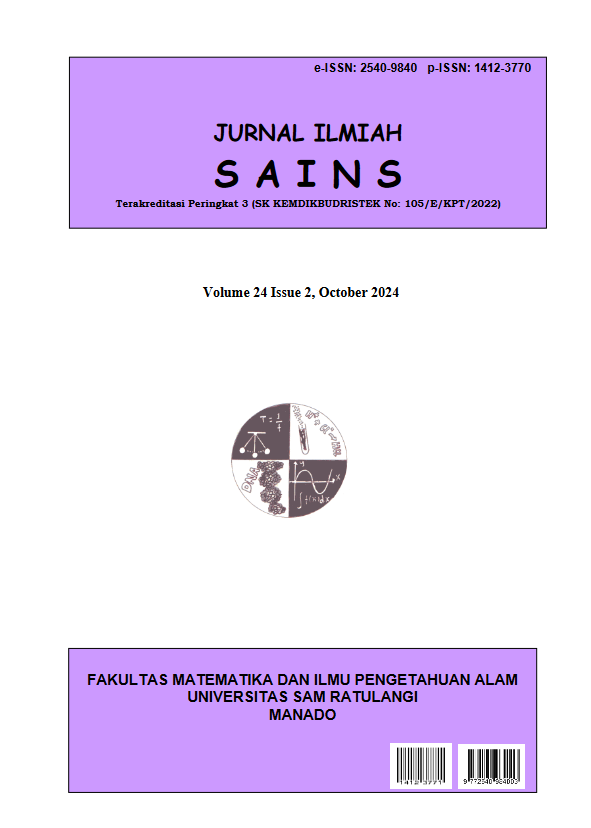Interpolation Methods: A Study of Solving Annual Data into Quarterly and Monthly Data
DOI:
https://doi.org/10.35799/jis.v24i2.55099Keywords:
Interpolated data, annual data, quarterly data, monthly data, diagnostic testsAbstract
This study aims to analyse the effect of Export Value (EKS_US$) and Exchange Rate (KURS_US$) on Gross Domestic Product (GDP) as a proxy for economic growth in Indonesia using multiple linear regression based on interpolated monthly data from annual data. In this paper, it is also explained about calculation examples, quarterly and monthly data interpolation methods using data from the Central Bureau of Statistics, namely Indonesia's Gross Domestic Product (GDP) for 2021-2022 at constant 2010 prices. Based on the calculation results, using multiple linear regression of monthly data for the 2018-2022 period, it shows that the estimated model has the best estimator, which is indicated by the variables used, passing the diagnostic test in the form of Multicollinearity, Heteroscedasticity, Autocorrelation, Normality, and Linearity tests. This indicates that the estimator value of the observed data is able to represent the random behaviour of the actual data. However, everything returns to the researcher, at which stage will be chosen is greatly influenced by various factors and considerations of the researcher. Thus, at certain stages and situations, it is very open to researchers to use data interpolation, especially on all data that has flow characteristics, such as GDP data, export values, exchange rates and others.
Keywords: Interpolated data; annual data; quarterly data; monthly data; diagnostic tests
References
Aljandali, A., & Tatahi, M. (2018). Economic and Financial Modelling with EViews: A Guide for Students and Professionals. Springer.
Baltagi, B.H. (2021). Classroom Companion: Economics (6th ed., Vol. 6). Springer Nature Switzerland AG.
Barry, R.R., & Bernarto, I. (2020). Spurious Regression Analysis on Time Series Data from Factors Affecting Indonesian Human Development Index in 1990-2017. JMBI UNSRAT (Jurnal Ilmiah Manajemen Bisnis Dan Inovasi Universitas Sam Ratulangi), 7(3), 592–611. https://doi.org/10.35794/jmbi.v7i3.30608.
Franses, P.H. (2020). Inclusion of older annual data into time series models for recent quarterly data. Applied Economics Letters, 28(19), 1717–1721. https://doi.org/10.1080/13504851.2020.1866152.
Franses, P. H. (2021). Interpolation and correlation. Applied Economics, 54(14), 1562–1567. https://doi.org/10.1080/00036846.2021.1980199.
Giles, D.E.A. (2007). Spurious Regressions with Time-Series Data: Further Asymptotic Results. Communications in Statistics-Theory and Methods, 36(5), 967–979. https://doi.org/10.1080/03610920601041499.
Gujarati, D. (2014). Econometrics by Example, Second Edition (Second). Palgrave Macmillan in the US is a division of St Martin’s Press LLC, 175 Fifth Avenue.
Insukindro. (1990a). Komponen Koefisien Regresijangka Panjang Model Ekonomi: Sebuah Studikasusimpor Barang Di Indonesia. Jurnal Ekonomi Dan Bisnis Indonesia, 5(2).
Insukindro. (1990b). Model Koreksi Kesalahan Untuk Permintaan Impor Bahan Bakar Minyak Di Indonesia. Jurnal Ekonomi Dan Bisnis Indonesia, 5(1).
Insukindro. (1990c). Penurunan Data Bulanan dari Data Tahunan. Economics and Finance in Indonesia, 38(4), 347–357.
Kindangen, P., Rotinsulu T.O., & Murni S. (2017). Human Resource Quality and Household Income in North Sulawesi, Indonesia. International Journal of Innovation and Economics Development, 3(5), 26-37. DOI: 10.18775/ijied.1849-7551-7020.2015.35.2002.
Kirana, W., & Nurwadono, N. (1992). Peran Pembangunan Sektor Keuangan dalam Mobilisasi Dana dan Pertumbuhan Ekonomi. Jurnal Ekonomi Dan Bisnis Indonesia, 7(1), 117–129.
Lamabelawa, M.I.J. (2018). Perbandingan Interpolasi dan Ektrapolasi Newton Untuk Prediksi Data Time Series. HOAQ: Jurnal Teknologi Informasi, 10(2), 73–80.
Lepot, M., Aubin, J.-B., & Clemens, F. (2017). Interpolation in Time Series: An Introductive Overview of Existing Methods, Their Performance Criteria and Uncertainty Assessment. Water, 9(10), 796–816. https://doi.org/10.3390/w9100796.
Oh, C., Han, S., & Jeong, J. (2020). Time-Series Data Augmentation based on Interpolation. Procedia Computer Science, 175, 64–71. https://doi.org/10.1016/j.procs.2020.07.012.
Okunade, S.O. (2018). Effect of Capacity Utilisation on Manufacturing Firms Production in Nigeria. Global Journal of Management and Business Research, 18(B1), 29–38.
Pratama, R., Sianipar, R.H., & Wiyajati, I.K. (2014). Pengaplikasian Metode Interpolasi dan Ekstrapolasi Lagrange, Chebyshev dan Spline Kubik Untuk Memprediksi Angka Pengangguran di Indonesia. Dielektrika, 1(2), 116–121.
Radianto, E., Prabawa, T.S., Therik, W.M.A., Sasongko, G., & Ndoen M.L. (2019) The Role of Tourism in Development: A Dilemma Between Economic Growth and Mangrove Forest Degradation (A Case Study of Regencies/Cities in North Maluku Province), Jurnal Manajemen Hutan Tropika 25(3), 185-198, EISSN: 2089-2063, DOI: 10.7226/jtfm. 5.3185.
Downloads
Published
How to Cite
Issue
Section
License
Copyright (c) 2024 Tri Oldy Rotinsulu, Elia Radianto

This work is licensed under a Creative Commons Attribution-NonCommercial 4.0 International License.
LICENCE: CC-BY-NC
This work is licensed under a Creative Commons Attribution-NonCommercial 4.0 International License







